Published in July 2021 and written by Jamie Anderson, this softcover book comes in the usual Amberley format of around 234mm x 165mm, is 96 pages long, and has 180 coloured photographs.
It has a published price of £15.99 but at the time of writing it can be obtained online from Amberley Publishing for £14.39 and from Amazon for around £11.
Jamie Anderson has compiled a wide selection of his own photographs taken between July 2015 and February 2020, featuring traction running on the European railway network.
Largely portrayed in two-per-page format, the countries appear in alphabetical order, Austria to Switzerland, with each section fronted by a summary of the country’s rail network and operators.
Traction covered includes both the national operator and private operators, featuring both freight and passenger workings.
Countries included are: Austria, Croatia, Denmark, France, Germany, Hungary, Italy, Norway, Slovakia, Slovenia, Spain, Sweden, and Switzerland.
The book is not split into chapters but is an illustrated record of the author’s visits to Europe between 2015 and 2020. With 180 colour photographs, this is simply a record of one person’s visits to a few European railway stations. And whilst there are some interesting photos, none are in the class of more notable railway photographers.
The author is a British rail enthusiast who regularly travels around Europe, capturing the continent’s rail scene. However, many of the photographs selected for this book were taken against the sun, with the inevitable result that much detail has been lost from the images, as they are mostly in shadow.
Regrettably, many photographs bear too much similarity to others in the same locations. For example, in the Norway section, there are four near-identical photographs of iron ore trains at Narvik. Also, each photograph was taken in very poor light in a snow-covered landscape, which renders the final image quite unclear,
The apparent lack of variety on Austrian railways is exemplified in these pages showing trains at Innsbruck and Villach.

Demonstrating that Europe is not devoid of interest, these pages of trains at Bratislava show that some countries still have much variety in their traction.

Considering that Switzerland has so many mountain railways, it is a pity that none have been included in this volume, whilst the author chose to include photos of two near-identical locos on the same page.

In summary, with many books on British railway subjects seeming to be variations of ones previously-published, the vast numbers of subjects waiting just across the English Channel must provide endless opportunities for a fresh approach to railway photography.
Continental Traction falls into the latter category. It is characterised by threequarter shots of locomotives at or approaching a limited number of station platforms. If this is what you are looking for it may be the book for you. But if you are looking for a variety of locomotives at different locations it is not.
The book does not have an index, but would have benefitted from replacing the book’s title at the top of each page with the relevant country.
The book is available to purchase from Amberley Publishing and from Amazon.
We would like to thank Amberley Publishing for providing RailAdvent with a copy of the book for review.






Responses